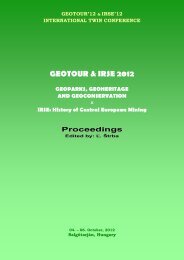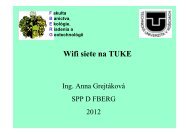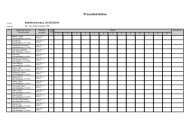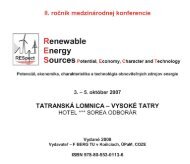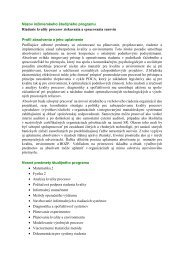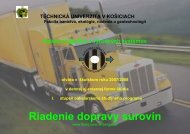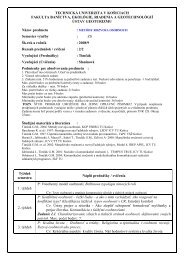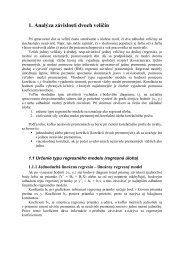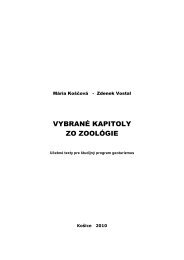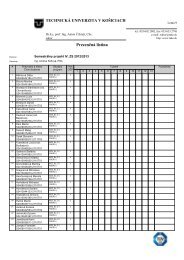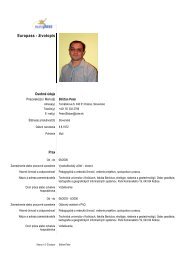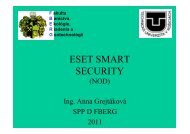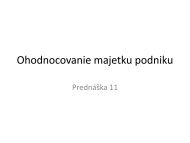GEOTOUR & IRSE 2012.pdf - Fakulta BERG - TUKE
GEOTOUR & IRSE 2012.pdf - Fakulta BERG - TUKE
GEOTOUR & IRSE 2012.pdf - Fakulta BERG - TUKE
Create successful ePaper yourself
Turn your PDF publications into a flip-book with our unique Google optimized e-Paper software.
Salgótarján, 04. – 06. October 2012<br />
Surface representation only works with a surface object, as can be made analytically<br />
or approximated by points, lines or polygons.<br />
Volume representation keeps the entire volume of the solid, that is, information about<br />
all points of space that an object occupies.<br />
Logical representation stores information about how the object was created from some<br />
simpler units (folding, intersection, difference, rotation, etc.).<br />
OBTAINING OF SPATIAL COORDINATES<br />
To obtain the spatial coordinates to create spatial models using various measurement methods.<br />
By Pavelka [2] methods to obtain the spatial coordinates are:<br />
Digital Photogrammetry (aerial, terrestrial, satellite) - Measuring method allowing<br />
modelling in 3D space using 2D images.<br />
Laser scanning (air, land) - is currently the most effective method of spatial<br />
measurement and creation three-dimensional (3D) models. It is a non-contact<br />
determination of the spatial coordinates, with extreme speed, accuracy, complexity,<br />
and safety, working on the principle of spatial polar method<br />
Triangulation 3D scanner - for obtaining the shape of small objects are devices that<br />
typically use a combination of several CCD cameras, laser pointer or other assistive<br />
devices.<br />
Radar Interferometry (air, satellite) - is a method of processing two or more radar<br />
satellite images used for the creation of digital terrain models or monitoring<br />
deformations of the earth's crust.<br />
surveying methods (land measurement)<br />
GNSS (Global Navigation Satellite Systems)<br />
Special (physical) - Physical Geodesy<br />
CREATING A SPATIAL MODEL BY LASER SCANNING<br />
For creation of spatial object model was chosen tunnel in the village Smolník. The historic<br />
mining town Smolník is located 18 km north of the southern part of Roņņava Volovské<br />
Vrchy. The beginnings of mining activities date back to the 11th century, but the first written<br />
mention of Smolník is up from 1243. Mining in the beginning focused on precious metals,<br />
especially gold and silver. He later moved to the mining of iron and copper, whose production<br />
base gave glory to Smolník mining for centuries. [4]<br />
At the foot of the hill, just opposite the local authority we can see the grated entrance to an<br />
underground passage. This leads the historic inn, where there are vast cellars. It is likely that<br />
in Smolník as in this passage gave miners dig to through it supplied the restaurant. It was<br />
easier to bring goods before pub and then bear down into the cellars where the need for cold<br />
storage of food. However, it is also possible that the old shaft was situated there earlier and<br />
just uses it as Smolnícka basement is pierced through and through, and lead mines of the<br />
Middle Ages did not keep any records. In the past, because in the village collapsed in the floor<br />
of several buildings, even in the heart. [4]<br />
The basic method of operation of the scanner is the polar spatial method. To determine the<br />
coordinates of a point P is necessary to know the length vector radius d (measured length) and<br />
angles ζ, ω. Angles are obtained as the position mirrors that scatter the laser bunch length as a<br />
rangefinder scanner pulse synchronized with the position of the mirrors. The result of the<br />
calculation of the 3D coordinates of the measuring point of the object in the coordinate system<br />
of the scanner, which is generally oriented and positioned. For scanning points objects is used<br />
distraction laser beam with which they are measured on the surface of the object points in the<br />
profiles of the selected density. Such measured points form cloud points. [3]<br />
68



